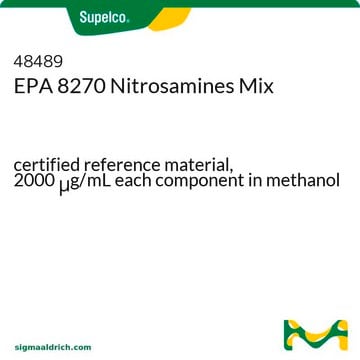추천 제품
분석
≥90% (GC)
형태
liquid
저장 온도
2-8°C
InChI
1S/C8H18N2O2/c1-2-3-6-10(9-12)7-4-5-8-11/h11H,2-8H2,1H3
InChI key
DIKPQFXYECAYPC-UHFFFAOYSA-N
애플리케이션
N-Butyl-N-(4-hydroxybutyl)nitrosamine (BBN), a carcinogen, is used to induce histiologically relevant aggressive urinary bladder cancer in animal models.
생화학적/생리학적 작용
Carcinogen used to induce urinary bladder cancer in animal models. The result of exposure is histologically comparable to human urinary bladder tumorigenesis. Used in chemopreventative studies.
포장
Packaged in a 100 mL serum bottle with butyl rubber stopper and aluminum tear seal.
주의사항
Injecting any compatible solvent permits preparation of any desired strength solution without exposure.
재구성
Dissolving the contents in 100 mL of solvent yields a 1% solution.
법적 정보
Isopac is a registered trademark of Merck KGaA, Darmstadt, Germany
신호어
Danger
유해 및 위험 성명서
Hazard Classifications
Acute Tox. 4 Oral - Carc. 1B
Storage Class Code
6.1C - Combustible acute toxic Cat.3 / toxic compounds or compounds which causing chronic effects
WGK
WGK 3
Flash Point (°F)
296.6 °F
Flash Point (°C)
147 °C
개인 보호 장비
Eyeshields, Faceshields, Gloves, type ABEK (EN14387) respirator filter
시험 성적서(COA)
제품의 로트/배치 번호를 입력하여 시험 성적서(COA)을 검색하십시오. 로트 및 배치 번호는 제품 라벨에 있는 ‘로트’ 또는 ‘배치’라는 용어 뒤에서 찾을 수 있습니다.
이미 열람한 고객
Yuji Sagara et al.
Cancer epidemiology, 34(3), 350-354 (2010-04-07)
Green tea polyphenol (GTP) suppresses malignancy in bladder cancer cell lines. However, the detail of its anti-carcinogenic effect in vivo is not fully understood. This study investigated the effect of GTP on bladder tumor size and angiogenesis in mice given
Inhibition of bladder tumor growth by chitooligosaccharides in an experimental carcinogenesis model.
João C Fernandes et al.
Marine drugs, 10(12), 2661-2675 (2013-01-25)
Urinary bladder cancer is one of the most common cancers worldwide, with the highest incidence in industrialized countries. Patients with cancer commonly use unconventional and complementary therapy including nutraceuticals. In this study we evaluated the efficacy of chitooligosaccharides (in orange
Koji Nishizawa et al.
International journal of cancer, 127(5), 1180-1187 (2009-12-30)
We previously reported that the expression of CXC chemokine receptor-4 (CXCR4) was upregulated in invasive bladder cancers and that the small peptide T140 was a highly sensitive antagonist for CXCR4. In this study, we identified that CXCR4 expression was induced
Xiao-Li Xie et al.
Food and chemical toxicology : an international journal published for the British Industrial Biological Research Association, 50(11), 3934-3940 (2012-08-15)
In the present study, effects of L-leucine and L-isoleucine on rat bladder carcinogenesis were investigated using AIN-93G and MF basal diet. In Experiment 1, N-butyl-N-(4-hydroxybutyl)-nitrosamine was used as an initiator of bladder carcinogenesis. In the AIN-93G diet groups, a significantly
Zhiming He et al.
Mutation research, 742(1-2), 92-95 (2011-12-14)
Bladder cancer is one of the few cancers that have been linked to carcinogens in the environment and tobacco smoke. Of the carcinogens tested in mouse chemical carcinogenesis models, N-butyl-N-(4-hydroxybutyl)nitrosamine (BBN) is one that reproducibly causes high-grade, invasive cancers in
자사의 과학자팀은 생명 과학, 재료 과학, 화학 합성, 크로마토그래피, 분석 및 기타 많은 영역을 포함한 모든 과학 분야에 경험이 있습니다..
고객지원팀으로 연락바랍니다.










![9-Borabicyclo[3.3.1]nonane solution 0.5 M in THF](/deepweb/assets/sigmaaldrich/product/structures/180/891/8b64e597-269d-4780-98b6-40889dfd06b9/640/8b64e597-269d-4780-98b6-40889dfd06b9.png)
